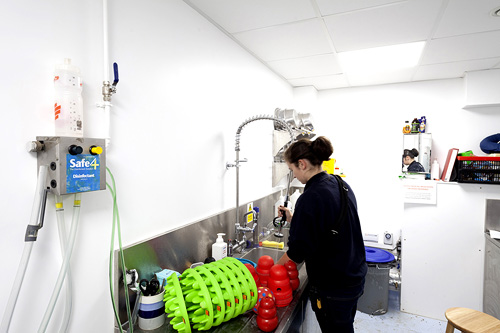
27th November 2019 | Blog Posts
This year marked the end of John Perkins Construction’s first major project in the animal care sector. Contracts Director Rupert Perkins talks with Bath Cats and Dogs Home’s Rachel Jones about the particular demands of building a state-of-the-art kennel block on a ‘live’ site.
The old saying goes: never work with children or animals. At John Perkins Construction, we make a habit of doing both. Our school building projects have earned us accolades like Most Considerate Site. It felt like a natural fit to use the same principles of safeguarding and sensitivity to move into the animal care sector.
At Bath Cats and Dogs Home, our construction of the Roy Hulbert Kennels, completed over 56 weeks, has given the charity a sector-leading space for rescued dogs and puppies. For John Perkins Construction, as principal contractor, the project was both exciting and challenging.
What did we learn over the course of the yearlong build? And what would we do differently next time?
1. Animal care facilities must be built to last
“We’re well aware that, across the country, there are lots of very basic kennels being built,” comments Rachel Jones, Head of Fundraising and Communications at Bath Cats and Dogs Home. “These type of facilities will quickly become obsolete.”
“We wanted to avoid that,” she continues, “by investing in a kennel block that’s built to last. The new kennels at Bath Cats and Dogs Home represent modern thinking, incorporating the latest behaviour knowledge.”
2. There is scope to mix mainstream design with specialist knowledge
 In order to create a facility that’s built to last, a certain amount of specialist animal care knowledge remains vital. With this in mind, we worked closely with experts in veterinary and animal welfare design and building management, ACD Projects.
In order to create a facility that’s built to last, a certain amount of specialist animal care knowledge remains vital. With this in mind, we worked closely with experts in veterinary and animal welfare design and building management, ACD Projects.
However, we discovered that it’s important not to be blinkered and find yourself siloed. There are plenty of dynamic design principles from outside the animal care sector that can elevate a new facility like a kennel block.
At Bath Cats and Dogs Home, it was possible to take the latest thinking in animal care and combine it with mainstream design principles. In this way, John Perkins Construction was able to add value and bring in tried-and-tested advice from other sectors.
3. Relationships with specialist suppliers are vital
Although there is a lot of value that can be added from a mainstream building contractor, some aspects of an animal care facility will always require a specificity that can only be achieved by working with specialist suppliers.
For the kennel block at Bath Cats and Dogs Home, we forged close relationships with specialists like Technik, to ensure the furniture and equipment fitted the brief.
4. The animals come first
 Securing safety and minimising disruption are the twin pillars of Health & Safety. But what happens when you’re working around not only human staff, but also four-legged residents?
Securing safety and minimising disruption are the twin pillars of Health & Safety. But what happens when you’re working around not only human staff, but also four-legged residents?
Bath Cats and Dogs Home’s base in Claverton Down, Bath, continued on as normal during the building works. This meant it was extra important for John Perkins Construction to be a ‘considerate constructor’ and uphold the principles of the CCS scheme.
“We found the John Perkins team to be very considerate,” says Rachel Jones. “It was the cleanest building project we’ve had, and disruption was kept to a minimum. Dogs will always bark when there’s something’s going on, but this was no more than usual.”
(Photo credit: Bath Cats and Dogs Home)
5. Communication with the client is key
When working on a ‘live’ site, where noisy or dusty works can upset both people and animals in the vicinity, we have learned that communication is key.
What’s more, at Baths Cats and Dogs Home, the build was managed by an internal project team (rather than the traditional trustee/architect model). Since some of the internal project team were unfamiliar with construction methods, it was important for John Perkins Construction to be on hand to explain technical aspects of the project.
“Having open lines of communication with John Perkins Construction was so important to us,” comments Rachel Jones. “JPC always told us what was going on, and they were very patient. The site manager, Paul Glennon, was friendly, approachable and efficient.”
6. A Softer Landing for the handover period
 We’re proud of our hard work on the kennel block and the fact that the finished facility has earned praise from the RSPCA. But the project definitely included its fair share of challenges, notably during the handover period. There was a slight loss of communication between the client and the site team at this stage, which could have been avoided.
We’re proud of our hard work on the kennel block and the fact that the finished facility has earned praise from the RSPCA. But the project definitely included its fair share of challenges, notably during the handover period. There was a slight loss of communication between the client and the site team at this stage, which could have been avoided.
In future, we intend to review and improve our Soft Landings measures, to ensure a longer monitoring support period following completion.
7. Open-book working would have added a further layer of transparency
Another area where we could have ensured even greater collaboration during the project was by using open-book working.
This type of model, where both sides agree management costs and Overhead and Profit, and then negotiate each stage of the project as it progresses, may not suitable for every type of job. However, at John Perkins Construction, we have been using open-book methods more and more. Why? Transparency isn’t just a buzzword to us. We genuinely think it makes projects run more smoothly, leading to better budgetary vision and control for the client.
Along with Soft Landings, open-book working is something we are seeking to expand our use of in the future.
Looking forward
It’s important for us to keep pushing ourselves. There’s no use in just congratulating ourselves on our accomplishments; we also need to analyse our mistakes. As we look to take on other construction projects in the animal care sector, we’ll be implementing our lessons learned – and, hopefully, reaching even greater heights of success.
Never work with children or animals, eh? We beg to differ.
Tags: lessons learned, Health & Safety, Third Sector, New Build, Rupert Perkins, bath cats and dogs home, animal care facilities
Share

John Perkins Construction is now in the position to start reopening its sites, progressing from...
Read more
John Perkins Construction, which temporarily ceased work on site last week, continues to closely monitor...
Read more
For the second year in a row, John Perkins Construction took home an accolade at...
Read more